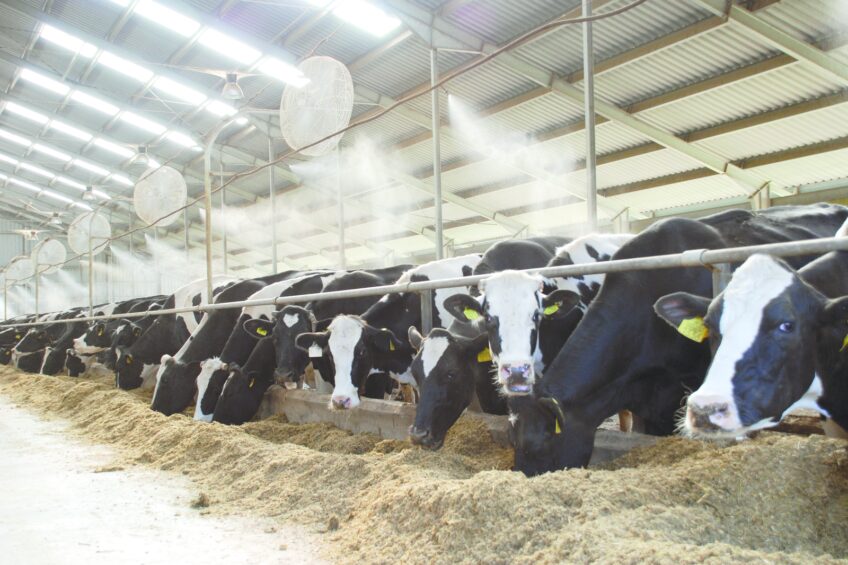Optimal ruminant performance during exposure to mycotoxins

Healthy reproduction status, organ functioning and milk production levels are important aspects in optimal performing ruminants. These aspects may be under pressure when consuming feed containing mycotoxins which are produced by moulds. Mycotoxins can also be transferred to humans via the consumption of dairy products. It is therefore of utmost importance to support ruminants in maintaining a good health status during exposure to mycotoxins.
In modern farming ruminants receive a combined diet consisting of forages, concentrates and silages. Due to poor weather conditions (rain, drought), weak crops and poor quality silage, individual feed components can be contaminated with moulds producing a very diverse number of mycotoxins. Some of these mycotoxins can successfully be inactivated by the rumen microbiota, whereas others pass unchanged, or are converted into metabolites that retain their biological activity. Especially aflatoxins (AFLA) and zearalenone (ZEA) are known to remain active and do affect reproduction, organ functioning, immune system and milk production, especially in high productive cows. Metabolites of mycotoxins, such as aflatoxin M1 (AFM1) from aflatoxin, can even end up in milk and can therefore be a health threat for humans. AFM1 does not lose its characteristics during processing and remains present in a variety of processed dairy products. In many cases a combination of mycotoxins are found in feed. Therefore, mycotoxin risks are often underestimated, since mycotoxins may act in an additive or synergistic manner.
Physiological effects of mycotoxins
Several studies on the effect of mycotoxins on the physiological status of ruminants have been published. Researchers in the UK demonstrated that aflatoxin B1 (AFB1) in the diet causes a significant decrease in milk production. AFB1 ingested via the diet can be converted in the liver to AFM1, which can be excreted in milk produced by dairy cows. AFM1 is toxic and carcinogenic to humans; therefore presence of AFM1 in milk is a public health concern.
AFB1 is a widely studied immune modulating agent. It acts primarily on cell-mediated immunity and phagocytic cell function. A study by US researchers showed that blood haptoglobin levels were increased in cows fed a diet containing 75 ppm of AFB1, which may indicate suppressed serum T-lymphocyte levels. Researchers in Iran demonstrated that already extremely low doses of AFB1 can reduce phagocytosis in dairy cows.
It appears that AFLA and ZEA have a direct effect on the reproductive performance by influencing hormonal and cellular functioning. Studies have shown that ZEA activates oestrogen receptors, resulting in functional and morphological alteration in the reproductive organs, which may reduce fertility. This effect was also shown by US researchers, who noted a decrease in the conception rate in heifers consuming feed with ZEA.
Selko Feed Additives has developed the TOXO portfolio to support animals in maintaining a good health status during exposure to a broad spectrum of mycotoxins. Multiple strategies are integrated which contribute to a healthy status of the animals. These strategies involve effective binding and components that stimulate the immune system and have proven effects in science and in vivo studies.
Efficiently binding mycotoxins
A common approach in dealing with mycotoxin contaminated feeds is the use of clay minerals as mycotoxin binders. The binder component of TOXO is composed of a blend of activated and purified smectite clays. By optimising the interlayer size by means of a specific heat treatment and purifying the smectite by removing the organic matter present in the interlayers, the binding efficacy as well as the binding spectrum are maximised.
The average transfer rate of AFB1 in feed to AFM1 in milk is 1-2%. Therefore, if aflatoxins can be bound efficiently, the risk of AFM1 in milk will be reduced to a great extent. Scientific research has indicated that smectite clays, or products high in smectite content, possess the best ability to tightly and efficiently bind aflatoxins. Maximum aflatoxin adsorption capacity can be indicated by Q-max. Table 1 shows Q-max values for AFB1 of different clay types. The combination of smectite clays have the highest binding capacity, followed by single smectites and bentonites.
Mineral clays are widely used for AFLA binding, however, scientific studies have shown that some smectite clays are also able to bind ZEA, which is known to be a difficult mycotoxin to bind. Previous in vivo studies with the smectite clays have shown that the inclusion of smectites can improve the growth and feed efficiency of pigs receiving DON and ZEA contaminated feeds. Also several authors have reported improvements of immunological, biochemical and histological parameters when smectites were included in ZEA contaminated diets of mice and mink.
In a recent study different types of binders were tested on their ability to bind ZEA in rumen fluid under in vitro conditions, mimicking in vivo conditions (Figure 1). Smectites and HSCAS show the highest adsorption of ZEA, which is consistent with previous studies that have indicated that smectite clays are among the most effective mycotoxin binders.
Immunity support
Since not all mycotoxins can be neutralised by binding, it is important to include additional mechanisms that go beyond binding to maintain optimal performance. A well-functioning immune system contributes to high production of cows. Feeding specific yeast cell wall fractions proves to contribute to a healthy immune status. Results from a study at the University of Kentucky (USA) indicated that supplementation of yeast cell walls to cows in dry period supports their immune response during exposure to rotavirus and tended to support the natural mechanisms for reducing transfer of rotavirus antibodies to calves.
In another study the effect of the specific yeast strain in the diet on the immune system of ruminating lambs was studied. They noted significantly higher γ-globulin levels and higher lysozyme activity in the blood serum of experimental lambs supplemented with the yeast extract and the proliferative response of blood lymphocytes after stimulation was improved as well (Figure 2). In a study on ewes it was found that the yeast supplement had a beneficial influence on the general health status. It supported humoral and cellular immune responses and the proliferative response of mitogen-stimulated T cells and B cells. Selko Feed Additives has studied several sources and has selected specific yeast cell wall fractions to include in the TOXO products to support the immune system.
Integrated strategy for best results
Since there is a high chance of multiple mycotoxins being present in ruminant feed, there is a need for broad spectrum mode of action products. Based on the above mentioned research findings, Selko Feed Additives integrated activated and purified smectites that effectively adsorb mycotoxins, in combination with specific yeast cell wall fractions to support the immune system with proven effects. With these solutions we strive to maintain optimal performance of ruminants during exposure to mycotoxins and to contribute to more safe food products for humans.
Join 13,000+ subscribers
Subscribe to our newsletter to stay updated about all the need-to-know content in the dairy sector, two times a week.













